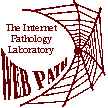|
In 1847 Dr. Ignaz Semmelweis's close friend, Jakob Kolletschka, cuts his finger while he is performing an autopsy. Shortly thereafter, Kolletschka dies of symptoms similar to those associated with puerperal fever. That gets Semmelweis's attention. Puerperal fever is killing 13% of the women who give birth in his hospital at the University of Vienna. The mortality rate is driving him crazy. He can't figure it out. A nearby public obstetric hospital, operated by midwives, loses only 2% of its patients to puerperal fever.
No one has connected microorganisms to disease yet. The first hint of that connection will come from England six years later. Joseph Lister won't show the medical community how to kill germs for another 18 years. Semmelweis is a Hungarian doctor teaching medicine in Vienna. He notices that students move between the dissection room and the delivery room without washing their hands. On a hunch, he sets up a policy. Physicians must wash their hands in a chlorinated lime solution whenever they leave the cadavers. The mortality rate from puerperal fever promptly drops to 2%.
Things now become rather strange. Instead of reporting his success at a meeting, Semmelweis remains silent. Finally, a friend publishes two papers describing the method. By now, Semmelweis has started washing medical instruments as well as hands. As outside interest grows, we begin to understand Semmelweis's silence. The hospital director feels his leadership has been criticized and he is furious. He blocks Semmelweis's promotion. Worse, the Viennese doctors begin to turn on this Hungarian immigrant. Finally, he returns to Budapest, where he brings his methods to a far more primitive hospital. He cuts death by puerperal fever to less than 1%. He does more. He systematically isolates the causes of death. He autopsies victims. He sets up control groups. He studies statistics. Finally, he writes a book on his methods (in 1861). The establishment gives it poor reviews. Semmelweis then grows angry and polemical. He hurts his own cause with rage and frustration.
Semmweis suffers a mental breakdown in 1865. Friends commit him to a mental hospital. There-as though to close the circle on this brief 47-year life-he cuts his finger. In days, he dies of the very infection that killed his friend Kolletschka and from which he managed to save thousands of mothers. That same year, Joseph Lister begins spraying a solution of carbolic acid during surgery to kill germs. In the end, it's Lister who finally gives our unhappy hero his due. He says, "Without Semmelweis, my achievements would be nothing."
Question 6.1: What is puerperal fever?
Puerperal fever (also known as childbed fever) is an old (now virtually obsolete) term for a bacterial infection of a woman's genital tract that occurs during or shortly after birth. ("Puerperal" means "childbearing".) The closest equivalent modern term is endometritis, which refers to a uterine infection following delivery or abortion.
Question 6.2: What is the historical significance of this disease?
It used to be a very common consequence of motherhood. Along with postpartum bleeding it was once among the leading causes of death in women. Death rates were often >10%.
Question 6.3: What are the symptoms of this disease?
Endometritis is characterized by the development of a persistent fever (oral T > 37.8ºC) early in the postpartum period. Other symptoms may include chills, headache, malaise, anorexia, tachycardia, and/or abdominal pain. There may be purulent or foul lochia, and physical examination typically reveals uterine or parametrial tenderness.
Question 6.4: How prevalent and significant is this disease today?
The overall rate of postpartum infection is now estimated between 1% and 8%. Endometritis is the most common genital tract infection following delivery. It develops more often after C
section than after vaginal birth. It can also occur after an incomplete abortion or during any uterine manipulation in the presence of an undiagnosed cervicitis or vaginitis. Nevertheless, the disease is now fairly uncommon (certainly far, far less frequent than in the "good old days"), thanks primarily to the use of modern antiseptic measures during delivery. The mortality is also far lower now that antibiotics are available to treat this type of infection.
Question 6.5: What are the most important causative agents?
Endometritis is usually associated with multiple organisms. Group A or B streptococci, Staphylococcus aureus, Bacteroides spp., Neisseria gonorrhoeae, Chlamydia trachomatis, enterococci, Gardnerella vaginalis, Escherichia coli, and Mycoplasma spp. are the most important causative agents.
Question 6.6: How is this disease treated?
Endometritis following vaginal delivery may be treated with ampicilin (2 g IV q6h) plus a gentamicin loading dose IV or IM (2 mg/kg body weight) followed by a maintenance dose (1.5 mg/kg body weight; q8h). This regimen should be continued for at least 48 hrs after substantial clinical improvement. (NOTE: Blood cultures should be taken immediately following the diagnosis, in case therapy must be adjusted to allow for resistant or unexpected pathogens.) Endometritis following C-section should be treated with ampicillin (2 g IV q6h) plus a gentamicin loading dose IV or IM (2 mg/kg body weight), followed by a maintenance dose (1.5 mg/kg body weight; qh8) and clindamycin (900 mg IV q8h). If Chlamydia is one of the causative agents, add doxycycline (100 mg PO bid for completion of a 14-day course of therapy). Erythromycin should be utilized if the patient is breast feeding.
| 


